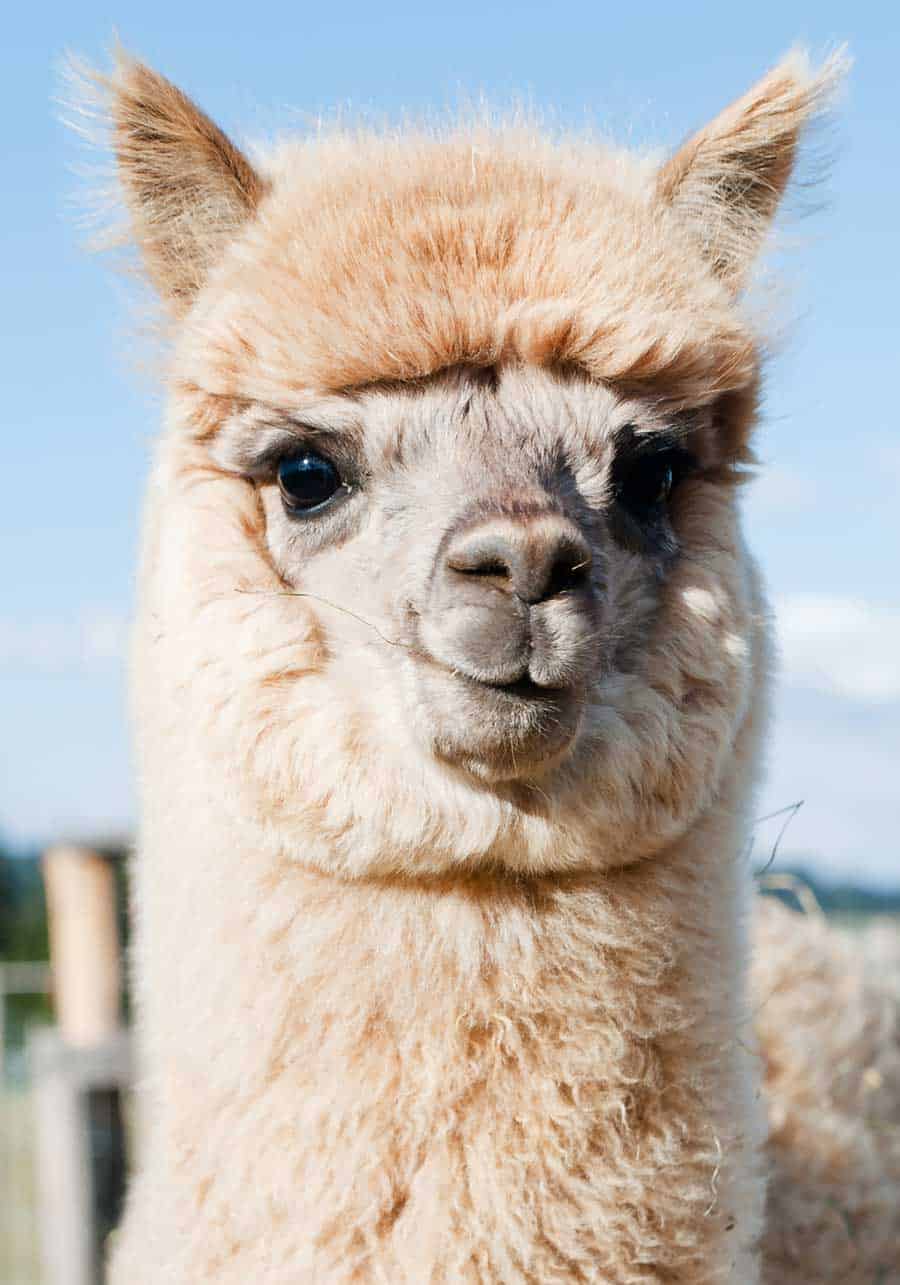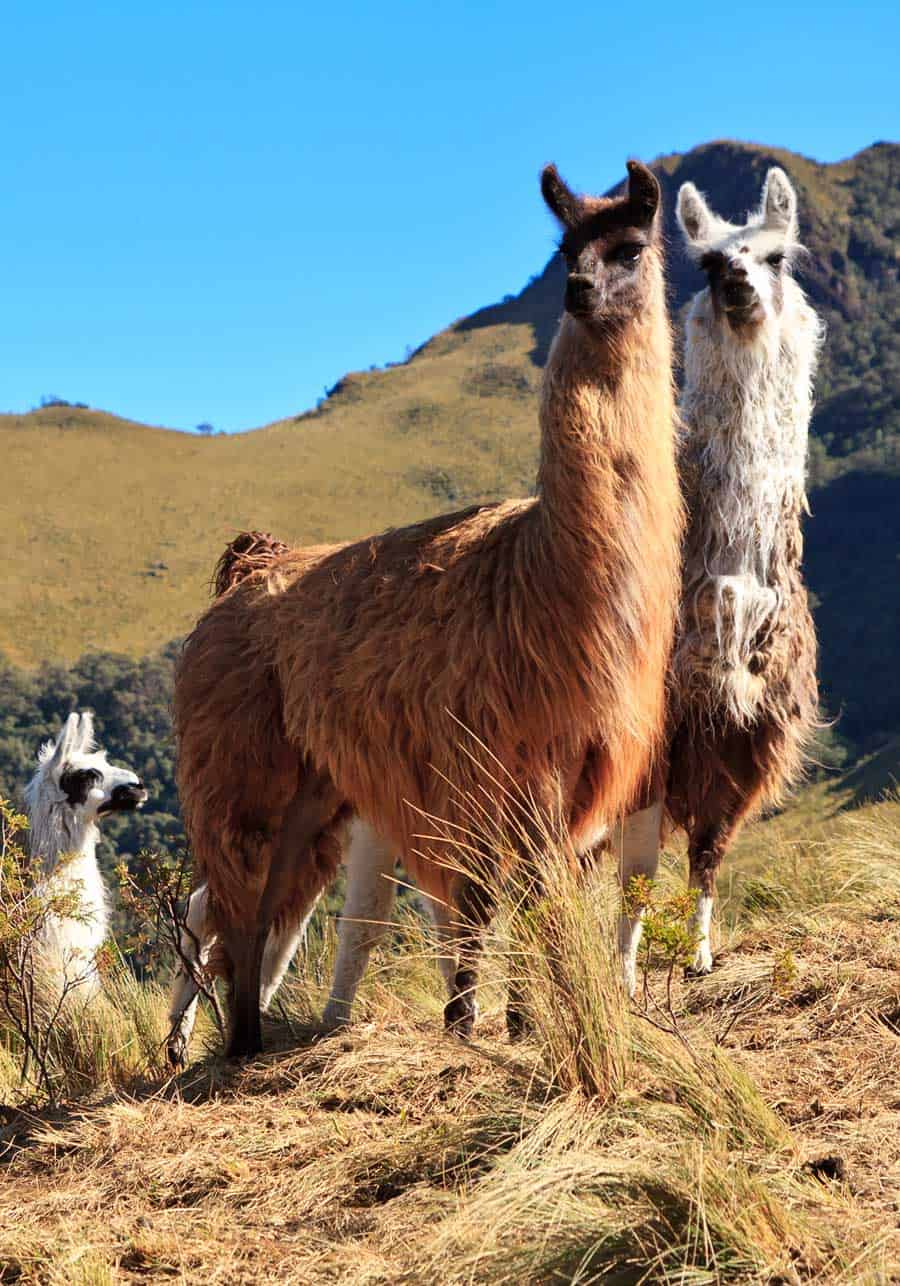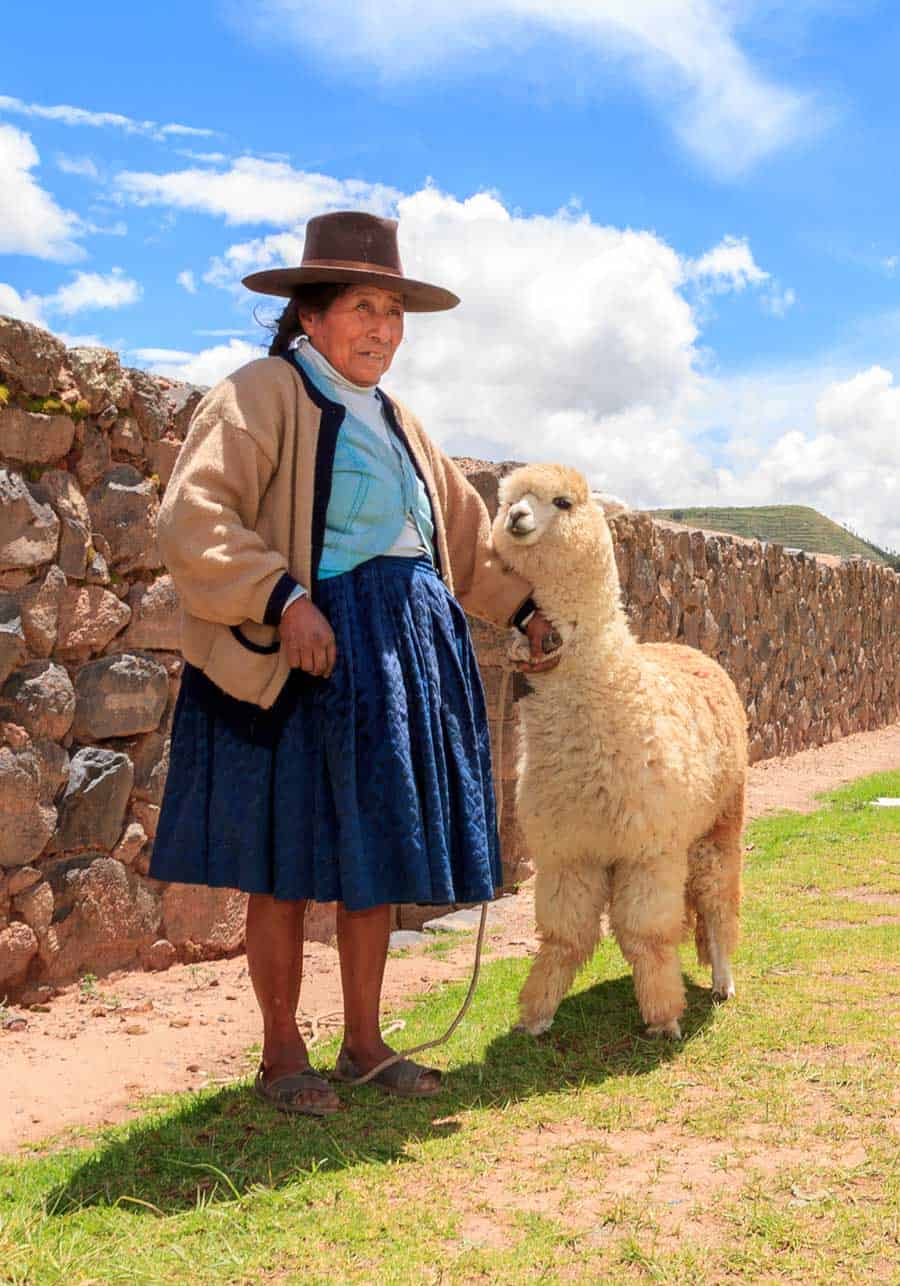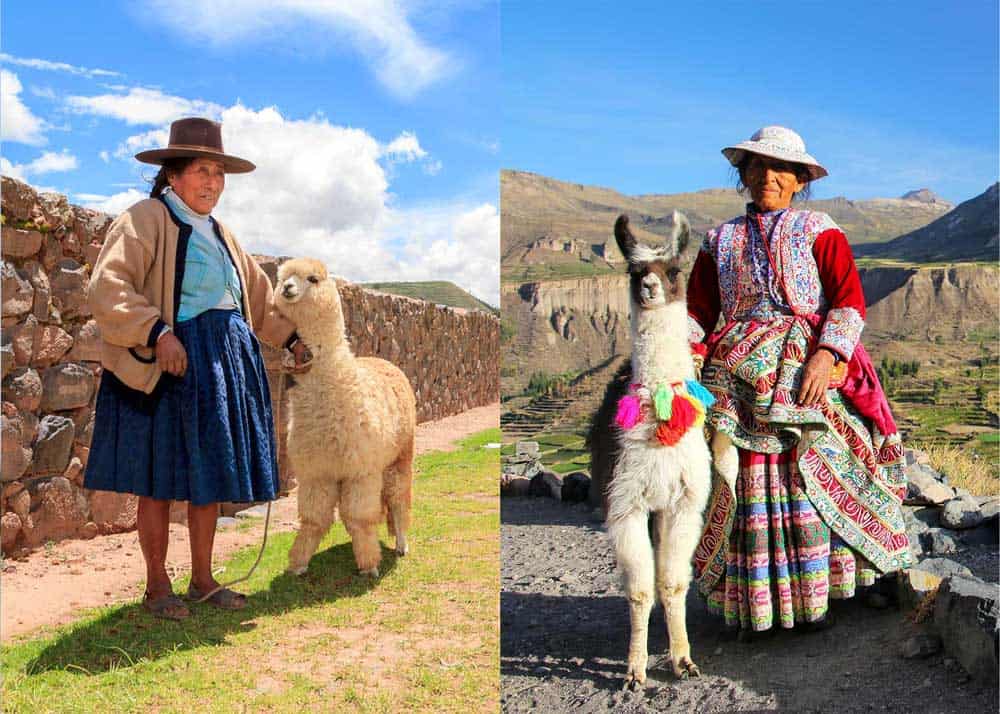They’re fuzzy. They’re friendly. They might spit on you, but it’s just a sign of love (probably). Alpacas and llamas have so much in common that it can look like you’re seeing double. Fortunately, it’s quite easy to tell llamas and alpacas apart, and their differences will become obvious to a well-trained eye.
Alpaca vs Llama? Although belonging to the same family, alpacas and llamas are quite different. Differences include face and ear shape, fur texture, size, function, and population. Here are the primary differences to tell llamas and alpacas apart.

Table of Contents
Alpaca vs Llama: 18 Ways to Tell Them Apart
Are you ready for an alpaca vs llama showdown? Let’s get started!
1. Ears
The ears are one of the quickest and easiest ways to distinguish between alpacas and llamas.
- Alpacas have short, straight ears. They’re pointed at the tips.
- Llamas have longer, more curved ears. They end with round edges rather than pointed ones. They’re sometimes called “banana-shaped” because of the way that they stick up and angle over the head.

Notice the distinct ears and soft face of the alpaca
2. Face shape
Alpacas and llamas have similar faces, but you can spot the differences when you know where to look.
The biggest difference is the presence of fur.
- Alpacas have very furry faces that give them a soft, squishy appearance. It can sometimes look like they have chubby cheeks, but that’s just their fur playing tricks on the eye! They also tend to have shorter, rounder faces in general.
- Llamas have longer faces with more chiseled features. Their fur is a lot shorter; it might even look like hair instead of fur.
While an alpaca face might resemble a stuffed animal, a llama face is more likely to remind you of a horse or camel.

Photos of llama face and ears
3. Fur
Alpacas have very soft and luxurious fur. It’s often compared to wool or cashmere, especially in terms of warmth. It grows so thickly on their body that it needs to be shorn every summer to prevent the alpaca from overheating.
Llamas also have a soft layer of fur, but it’s found underneath a coarser topcoat. You’ll need to get through the prickly top layer to reach the finer, gentler fur beneath it.
4. Fiber
Didn’t we just talk about their fur? Yes, but there’s a difference between the fur on their bodies and the fur that’s been shorn for commercial purposes.
In the latter case, it stops being called “fur” or “fleece” and starts being called “fiber.”
- The fiber of an alpaca is very soft and fine. It measures 18 – 30 microns and is great for things like sweaters, socks, mittens, scarves, and bed covers. It doesn’t contain any lanolin, so it isn’t waterproof, but the lack of lanolin also makes it hypoallergenic.
- Llama fur is thicker and coarser, so it isn’t usually turned into clothing. The top layer is made into ropes, rugs, and wall hangings; the undercoat can be spun into thicker kinds of yarn. Llama fur measures 50 – 65 microns.
5. Color
Alpacas and llamas come in a variety of colors. They can be white, black, gray, brown, beige, and even reddish-bronze.
It isn’t possible to distinguish an alpaca and a llama by the color of their fur alone. But one of the subtler differences between alpacas and llamas is that alpacas come in more colors.
They have 22 shades among them.

Color differences among llamas in Ecuador
6. Tails
Alpaca tails can be short and fluffy or long and curly. They usually slope or hang down from the alpaca’s back.
This downward trajectory isn’t a universal feature, but it’s common in the most populous alpaca breed, so it can be seen as a semi-distinctive characteristic of the species.
Llama tails tend to be shorter and straighter than alpaca tails. They usually stick up instead of sloping down. Again, this isn’t true of every llama on the planet, but it’s common enough.
7. Jaws
While alpacas and llamas both have long, giraffe-like necks, there’s a key difference when you reach their faces.
- Alpacas don’t always have a visible jaw. Their face can be furry enough that their jawline is hidden beneath the fluff, and if they have round facial features on top of that, it can look like their neck just continues into their face without stopping.
- Llamas, on the other hand, have very visible jaws. They jut out from their faces like horses or camels, and there’s very little fur to cover them. You’ll almost always be able to see a llama’s jaw.
When you look at pictures of alpaca and llama skulls, you’ll see that their shapes are almost identical.
Llama skulls are a bit more elongated than alpaca skulls, but that’s it. The only real difference is that one jaw gets hidden by fur and one doesn’t.
This is why it’s harder to see the differences when an alpaca has been freshly sheared of its fur.
8. Backs
If you’re ever in doubt about alpacas vs llamas, look at their back. If it’s rounded, it’s probably an alpaca. If it’s long and flat, it’s probably a llama.
- Alpacas can have flat or rounded backs. It can be hard to tell their exact shape because of the thick layer of fur covering them, but both are common.
- Llamas usually have broader, flatter backs. This is because they’ve been bred as working animals for centuries, and one of their most common tasks is carrying cargo.
Some people even breed llamas specifically for this purpose: They’ll mate the males and females with the widest backs in hopes of having more offspring like them.
9. Size
- Alpacas are the shorter animals. They can measure anywhere from 80 – 100 centimeters (32 – 39 inches) and usually look thicker and stockier thanks to all of their fur.
- Llamas are a head taller than alpacas. They measure between 106 – 116 centimeters (42 – 46 inches), and they usually have a leaner appearance since their bodies aren’t covered in as much fur.
Both alpacas and llamas are measured by withers. This means that their height is recorded at the top of their shoulders rather than the top of their head or the tip of their ears.
Since the latter forms of measurement can change whenever the animal moves its head, the shoulder measurement is considered more stable and accurate.

Alpaca in Peru, standing beside a woman

Llama in Peru, standing beside a woman
10. Weight
In addition to their shorter stature, alpacas are also lighter than llamas. Their average weight is around 150 pounds, but they can range anywhere from 100 – 185 pounds.
Llamas are twice as heavy as alpacas. Their average weight is around 400 pounds, but they can fall anywhere on the scale from 290 – 450 pounds.
11. Breeds and Types of Llama and Alpacas
There are two types of alpacas:
- Huacaya alpacas make up around 90 percent of the alpaca population. They have thick, dense, curly, or crimped fur that’s often compared to the texture of a teddy bear. Huacaya alpacas originated in the high mountains of the Andes where it’s very cold, so their heavy fur was a matter of survival.
- Suri alpacas make up the remaining 10 percent of the alpaca population. Their fur is made of long, fine fibers that droop down like weeping willow trees. They came from warmer climates and lower elevations.
Llamas have no distinct breeds. You might find mentions of “Huacaya llamas” or “Suri llamas” based on the appearance of their fur, but this is a casual classification and not an officially recognized category.
12. Trekking
- Alpacas aren’t very good trekkers. They’re too skittish to be comfortable around large groups of people, and historically, they’ve never been bred as working animals. Individual alpacas can be trained to perform tasks, but manual labor just isn’t their calling.
- Llamas have a long tradition of being used as trekkers. They’re smart enough to follow instructions and docile enough to be safe around tourists, so people often use them as porters, haulers, and cargo carriers.
Llamas can carry 50 – 100 pounds for up to 10 miles before they get tired! They’re comfortable handling up to 25 percent of their own weight, and since they can tip the scales at 400 pounds or more, that translates to a lot of luggage.
13. Spitting: 4 Reasons Llamas and Alpacas Spit
Spitting is done by both alpacas and llamas for a number of reasons:
- Dominance battles. Males of the herd will spit, kick, headbutt and ram into each other to decide which one is more dominant. Females will spit at other females to keep them in line.
- Protection of resources. They might be social animals, but alpacas and llamas can still warn others away from their lunch! They’ll spit to tell the other guy to back off.
- Mating. Females might spit at a male that tries to mate with her, especially if she thinks that she’s already pregnant.
- Camaraderie. It might sound strange, but being a little rough with you can be a sign that an alpaca or llama accepts you as one of their herd. This isn’t actually a good thing, however. You’ll want to establish dominance over them if you want them to follow your commands and not spit or behave aggressively when given instructions.
Generally speaking, there’s no difference between the spitting of an alpaca and the spitting of a llama. This is one area where they’re pretty much identical.
14. Temperament
Alpacas and llamas have similar personalities. They’re both gentle, peaceful, playful, and intelligent species. They’re commonly featured in things like fairs and animal shows. They’re popular on family ranches since they present no danger to children or livestock.
Another similarity is that they’re both herd animals. Alpacas and llamas are social breeds, and they live together in groups. They like to form herds with dominant males that protect the females and the offspring.
There are some differences in temperament:
- Alpacas tend to be more skittish than llamas. They’re easily startled, and when they’re being threatened by a predator, they’ll lump together in a defensive group rather than attack the outsider.
- Llamas are more confident and independent. They’ll chase down a predator on their territory, and they don’t mind detaching from the herd to do it. Llamas can even be used as sheepdogs to guard a pack of alpacas!
15. Purpose
Alpacas are raised for one purpose: their fur. It’s been considered a commodity for thousands of years, and humans have gotten quite good at breeding specific types of alpacas based on the length, color, and texture of their fur. Some people also breed alpacas for meat, but this is much less common than wanting their soft, luxurious fur.
Llamas are kept as beasts of burden, for tourism, and also for their fur. Llamas make great workhorses, and they can be used to transport cargo, guard livestock and lead tourists on wildlife trails.
Kids can even ride llamas! They’re tranquil animals that are able to carry up to 100 pounds at a time, so small children are just another backpack for them.
16. Habitat / Region
Alpacas are native to Peru. Originally a thriving species, their numbers were decimated by a whopping 98 percent when the Spanish invaded the Andes mountains in 1532.
Alpacas had to move higher into the mountains to survive. Thankfully, they were rediscovered and bred back to non-critical population size, and they can be found all over the world today.

Peruvian women with an alpaca and a llama
Llamas are also native to Peru. But since they’ve been used as beasts of burden for centuries, they were dispersed through the world at a faster rate. They were a favorite of the Incan empire, for example, so they traveled all over Ecuador, Bolivia, Argentina, Chile, and Colombia.
Llamas were exported to Europe sometime in the 18th or 19th century. They’re currently found all around the world just like alpacas.
17. Classification
Alpacas and llamas both belong to the camelid family, but they’re classified as two separate and distinct species.
- Alpacas are similar to an animal known as the vicuna. Vicunas are short and fuzzy just like alpacas, and they live in the high mountains of the Andes. Their fur is extremely soft. They were hunted to near-extinction in the 1900s, but they’re back to a sizeable population now.
- Llamas are similar to the guanaco. Guanacos are smaller and lighter than llamas, but they’re much bigger than alpacas and vicunas. They also share the llama’s unique fur pattern; they have a coarse topcoat and a softer, finer undercoat.
All four of these camelid species get mistaken for one another, especially since they share the same habitats in South America.
However, each one is a distinctive species, and they’re even put into separate genus groups:
Vicugna
- Vicugna vicugna (vicuna)
- Vicugna pacos (alpaca)
Lama
- Lama guanicoe (guanaco)
- Lama glama (llama)
18. Population
- 100,000+ alpacas in the U.S. and Canada
- 158,000+ llamas in the U.S. and Canada
It’s estimated that there are more than seven million llamas and alpacas in their native South America.
Their individual numbers haven’t been counted, but their overall ratio to each other is probably the same.

Three alpacas in a field
Love llamas? Check out my fun llama gift ideas.
Crazy Camelids
These are just a few of the differences between alpacas and llamas. Some of them are quite subtle; others are glaringly obvious once you know what to look for or how to classify them.
The next time that someone challenges you during a trivia game, you’ll be ready with some prime alpaca vs llama facts!
Drew Haines is an animal enthusiast and travel writer. She loves to share her passion through her writing.
She graduated high school at sixteen and started her own business, Everywhere Wild Media. And she runs Everywhere Wild and JustBirding. She also guest blogs on Storyteller.Travel
She lived in Ecuador for 6 years and explored the Galapagos Islands. Currently based in N.S., Canada.
